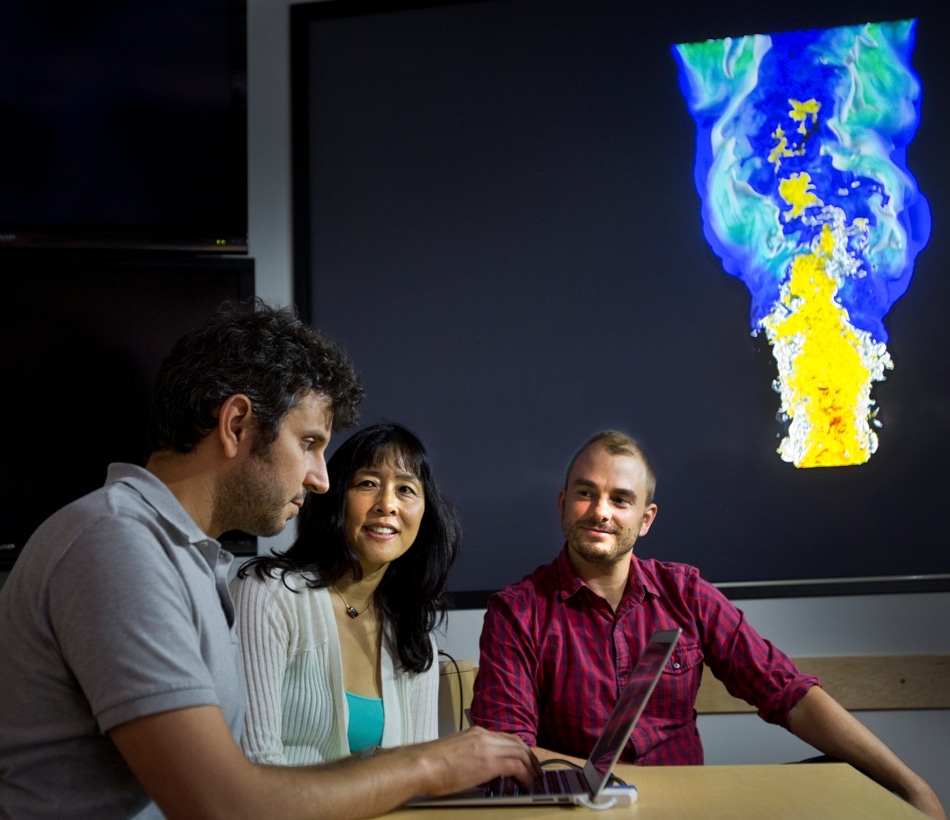Oct 13 2017
One may think the term "cool flame" sounds like an oxymoron. However, it is an important constituent in diesel combustion, a constituent that when properly perceived can lead to the development of superior engine designs that have lesser emissions and higher efficiency.
 Sandia National Laboratories researchers Giulio Borghesi, left, Jackie Chen, center, and Alex Krisman discuss a flame simulation. CREDIT: Dino Vournas.
Sandia National Laboratories researchers Giulio Borghesi, left, Jackie Chen, center, and Alex Krisman discuss a flame simulation. CREDIT: Dino Vournas.
Jackie Chen, a Mechanical Engineer at Sandia National Laboratories, and her collaborators Alex Krisman and Giulio Borghesi have recently determined the usual property of an important, temperature-reliant characteristic of the ignition process, known as a cool flame, in dimethyl ether fuel.
Use of the adjective cool is correlated: the cool flame is ignited at <1150 °K, or 1610 °F, which is nearly half of the usual flame ignition temperature of 2200 °K. Although it was in the early 1800s that cool flames were first identified, their characteristics and advantages of usage in diesel engine design have been analyzed only in the recent past.
We’re trying to quantify the influence of cool flames in stratified turbulent jets during the ignition and flame stabilization processes. The insights gleaned will contribute to more efficient, cleaner burning engines. Our holy grail is to understand the physics of turbulent mixing coupled with high-pressure ignition chemistry, to aid in developing predictive computational fluid dynamics models that can be used to optimize engine design.
Jackie Chen, Mechanical Engineer, Sandia National Laboratories
The study carried out by the Researchers has demonstrated that in the course of autoignition, or spontaneous burning of fuel injected into a combustion engine, cool flames speed up the generation of ignition kernels (i.e. tiny localized high-temperature sites that fuel a fully burning flame) in fuel-scarce areas. The research was conducted at Sandia’s Combustion Research Facility by adopting Direct Numerical Simulations—a high-power numerical experiment with the ability to resolve all turbulence scales. The Lead Author of the study, which was reported in the Proceedings of the Combustion Institute, is Krisman. The Department of Energy’s (DOE’s) Office of Basic Energy Sciences supported the research.
Borghesi furthered the cool flame research by conducting a three-dimensional investigation of n-dodecane—an alternative fuel for diesel, which has been the latest to attract the attention of Sandia’s Engine Combustion Network on spray combustion in diesels. The research authored by Krisman using dimethyl ether (a simpler fuel) was two-dimensional. Borghesi’s paper has not been published yet. Overall, the papers of Krisman as well as Borghesi will be part of an extensive investigation of low-temperature chemistry in autoignitive flames at various ignition stages.
Cool flames can improve engine design
Normally, the particulars of starting an engine are only assumed. In contrast to a gasoline engine where the fuel-air mixture is combusted with a spark plug, a diesel engine mandates auto-ignition of fuel upon being injected into the compressed, hot air in the piston on top of the piston stroke. When the fuel is introduced into the engine cylinder, quick mixing and ignition together lead to burning of the fuel, thereby driving the engine. Although this phase lasts for only fractions of a second, the flame conditions that initiate this strong process are highly significant for enhancing engine efficiency and reducing pollution.
Investigations of the cool flame were carried out at the DOE’s Oak Ridge Leadership Computing Facility by using Titan (a 27-petaflop supercomputer) through a computational grant from DOE INCITE, or Innovative and Novel Computational Impact on Theory and Experiment. Calculations performed by adopting one of the largest supercomputers (e.g. Titan) are inevitable for precise and elaborate computation of the autoignition process.
Combustion processes are challenging to study because the fuel itself is quite complicated. Fuel oxidation chemistry consists of hundreds of species and thousands of chemical reactions. A realistic simulation of diesel combustion needs to capture this complex chemistry accurately in an overall model that includes turbulent mixing and heat transfer.
Giulio Borghesi
For the DOE Exascale Computing Program, the researchers have collaborated with other institutions—such as NVIDIA; Lawrence Berkeley, Oak Ridge, Argonne, and Los Alamos national laboratories; the National Renewable Energy Laboratory and Stanford University—for developing performance-portable algorithms with the ability to improve the calculation efficiency in the case of Direct Numerical Simulation combustion investigations.
Team focus turns to speed, structure of flames in diesel engines
Henceforth, the Researchers aspire to analyze fundamental questions related to the structure and speed of flames under diesel engine conditions and to investigate the link between ignition, spray evaporation, mixing and soot processes intrinsic to multicomponent fuels.
Such fundamental questions will pave the way for the analysis of the cool flame’s important role in the synthesis of engine energy and employ the important potentials of Direct Numerical Simulations run on exascale supercomputers as a highly accurate and elaborate numerical simulation technique.